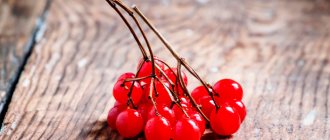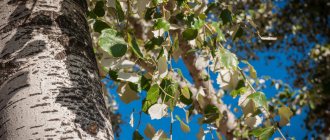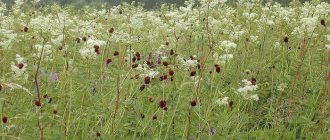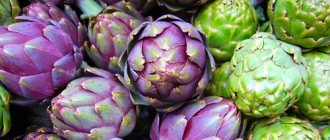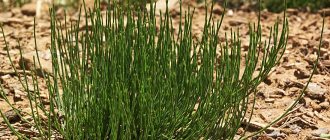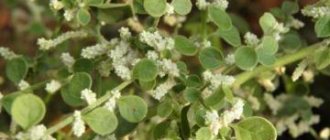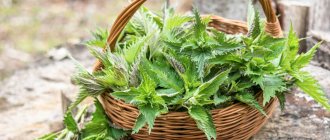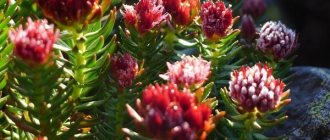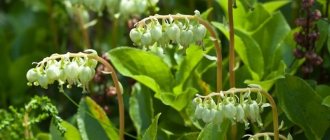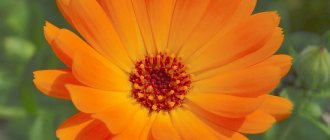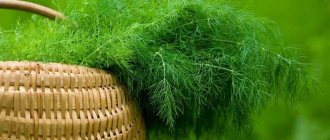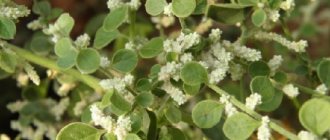Benefits of chamomile for the body: chemical composition, what helps and how to take it?
The therapeutic effect of consuming common chamomile flowers is explained by the presence in it of a large number of biologically active components that can have a mild anti-inflammatory, analgesic, antimicrobial, reparative, and sedative effect.
Chamomile-based preparations can have a stimulating effect on smooth muscles, which can have both a therapeutic and the exact opposite effect.
What does chamomile look like?
A member of the genus Matricaria of the Asteraceae or Asteraceae family, chamomile (Matricaria chamomilla) is well known to everyone for its elegant flowers. This herbaceous annual plant blooms only once and dies soon after flowering. The lifespan of Matricaria chamomilla is 3-4 months.
The plant is a low (up to 0.6 m) herbaceous bush with a branched stem, pubescent, ribbed and hollow inside. All above-ground parts have a strong characteristic odor.
The leaves consist of thread-like pointed lobes covering the central and lateral veins. The leaf sizes are 1.5-6 cm in length and 0.5-1.8 cm in width.
At the top of each branch and stem of the plant, inflorescences-baskets of small tubular yellow flowers develop. Inflorescences (they are called flowers) with a diameter of up to 2.5 cm are surrounded by female flowers with white tongues (petals) no more than 14 mm long. At the ends of the tongues you can see five cloves.
At the beginning of flowering, the tongues are directed upward, then they are located perpendicular to the peduncle, and over time they fall down. In this case, the basket seems to turn outward, taking on a convex oval shape.
As a sedative
What else is chamomile tea good for? It is often used as a sedative and to normalize sleep. Moreover, the herb has long been used as a mild sedative. With regular use, most people notice improved sleep, anxiety will disappear, and the body will rest better.
Using the flower as a sedative is quite easy:
- 1 teaspoon of dry herb, pour a glass of boiling water.
- Cover with a lid and let the broth brew for 10 minutes.
- Strain the infusion through a fine sieve or cheesecloth.
- Cool everything to a comfortable temperature.
- You can add honey and lemon juice before use.
This tea has only a slight sedative effect. A person experiences calmness and worries recede.
origin of name
In the ancient world, the chamomile plant was known as chamaemelon, which translated from ancient Greek means “earth apple.” Chamomile was so named due to the aroma of its flowers, reminiscent of the smell of apples. In medieval Europe, the plant was called chamaemelon romana, the second word indicating the ancient Roman origin of the name.
In Russian, romana was transformed into “novel”, “romannik”, “romanov color”. By the end of the 18th century, the diminutive form of these names, “chamomile,” became widespread.
The scientific name Matricaria chamomilla was assigned to the plant in the 18th century. A doctor and botanist from Switzerland, Albrecht von Haller, decided to name one of the genera of the Asteraceae family - Matricaria, taking as a basis the Latin name for the uterus - matrix.
This word was not chosen by chance, because a close relative of chamomile, non-odorous chamomile, has long been used to treat gynecological diseases. Subsequently, three-rib was isolated into a separate genus, and the name that appeared, thanks to it, went to the genus of the Astrov family, to which chamomile belongs.
The specific name chamomilla was introduced into the botanical classification by the Swedish botanist Carl Linnaeus, taking the Latin name chamaemelon as a basis.
Composition and calorie content
Let's start with the calorie content of chamomile infusion - 9 kcal per 100 ml of decoction.
As part of the chamomile infusion, it contains many useful microelements and vitamins, thanks to which doctors and cosmetologists fight various diseases and serious illnesses. Even Avicenna and Hippocrates used chamomile in their practice. Let's list some of the elements that are part of the "chamomile potion":
- potassium:
- iodine;
- calcium;
- boron;
- aluminum;
- selenium;
- magnesium;
- iron;
- zinc, etc.
- ascorbic acid, salicylic acid, nicotinic acid must be isolated from natural compounds;
- tanning elements;
- pectin;
- sugar, etc.
Among the medicinal substances present in chamomile, we note the following::
- Apigenin. This substance actively fights inflammation, normalizes the nervous system, and promotes the synthesis of neurons. According to some reports, apigenin is one of many drugs that can fight the development of cancer cells in the body.
- Bisabolol. Thanks to its antibacterial properties, this substance effectively soothes skin irritations and stops inflammation. Some scientists are inclined to believe that bisabolol may help treat leukemia. When taken orally, pepsin production is reduced, which has a beneficial effect on the functioning of the digestive system.
- Qumarin. This is an excellent remedy for stabilizing blood clotting. Helps with asthma.
- Flavonides. They are also called natural antioxidants because they actively fight harmful viruses and microorganisms.
- Sesquiterpenes. This substance is an anthelmintic.
- Hamazulen. This is an excellent antiseptic.
Variety of chamomile species
In addition to chamomile, the genus Matricaria, which belongs to the Asteraceae (Asteraceae) family, includes about 20 more species. Of these, the most common are odorous (tongueless) and non-odorous (canine) chamomile. Most representatives of the Chamomile genus have yellow caps of inflorescences surrounded by narrow white petals, so they are often confused with chamomile.
Representatives of other genera of the Asteraceae family are also often mistakenly classified as daisies: similar varieties of gerberas, asters, chrysanthemums, as well as such species that are difficult to distinguish from Matricaria chamomilla, such as cornflower (meadow chamomile), three-rib, navel (garden chamomile), pyrethrum.
Some species of the genus Matricaria, for example, chamomile, as well as similar plants of other genera - cornflower, navel, three-rib, are used as medicinal raw materials.
However, drugs based on them are less effective and are mainly used externally. After all, their chemical composition does not contain chamazulene, a valuable substance that chamomile flowers are rich in.
Chamazulene is an isomer of naphthalene with bacteriostatic, anti-inflammatory and anti-allergenic activity. It is thanks to its content that chamomile is so highly valued.
What are the benefits of chamomile for the body?
Medicines based on chamomile raw materials are capable of:
- Relieve the symptoms of gastrointestinal diseases.
- Relieve pain in case of poisoning or dyspeptic disorders.
- Provide a general sedative effect on the body, which helps relieve insomnia and relieve symptoms of stress.
- Reduce the intensity of the inflammatory process and the pain that accompanies it.
- Accelerate the healing of ulcers, scratches and various wounds.
- Restore the broken cycle, speed up the onset of menstruation.
Chamomile flowers are leaders in the content of phenols and flavonoids, which have powerful antioxidant properties that protect cell membranes from peroxide damage.
Moreover, in terms of antioxidant content, the plant is far ahead of almost all medicinal herbs, including the famous yarrow.
Flowers are also rich in vitamins and vitamin-like substances - A, PP, C, E and nicotinic acid - but they are contained in relatively small quantities, which means using chamomile to replenish vitamin deficiency is absolutely impractical.
As vitamin and immunostimulating agents, it is better to use preparations based on rose hips, ginger, currants (both berries and leaves), ginger, lemon and orange (both the fruit itself and the zest are suitable).
Green (medicinal) and Roman chamomile inflorescences are suitable for medicinal use. Which, for ease of use, are sold both in loose form and in tea bags.
Differences between chamomile and similar species of the family
How to distinguish pharmaceutical chamomile from plants that are very similar to it? Its leaves have a needle-like structure, unlike meadow chamomile, which is characterized by a continuous leaf plate. The drugstore chamomile is distinguished from three-ribs and dog chamomile by a strong, specific aroma.
An important distinguishing feature is also the appearance of the inflorescences - in the pharmaceutical variety they are small in diameter (together with the petals no more than 5 cm) and as they develop they acquire an elongated shape with tongues bent towards the peduncle.
If you cut a mature inflorescence lengthwise, you can see that the receptacle is narrowly conical, hollow inside, its outer surface does not have scales, films or bristles found in other representatives of the genus.
So, we can highlight the following distinctive features of chamomile:
- when rubbing all above-ground parts of the plant, a strong aroma is felt;
- openwork leaves consisting of thread-like lobules, reminiscent of dill;
- strong branching of the stem, each shoot has an inflorescence at the end;
- the inflorescences have a strong pleasant aroma, their middle is convex, and as they bloom the convexity
- enlarges, petals press against the peduncle;
- white petals in the amount of 12-18 pieces, each no longer than 14 mm, with five teeth at the end;
- if you separate the yellow flowers from the receptacle, it will be smooth, without films or scales, the hollow inside Matricaria chamomilla develops slowly and in the initial stages of development is often suppressed by other plants, therefore in nature its thickets do not occupy large areas, unlike, for example, cornflower, which grows in meadows, displacing other meadow grasses.
Knowing these signs is enough to avoid confusing chamomile with other similar plants.
Treating a runny nose with chamomile
A decoction for a runny nose.
Washing noma with this medicinal plant helps to quickly get rid of a runny nose. In this way you can even treat a runny nose in a child. To do this, the decoction should be injected one drop into each nostril. But this must be done very carefully. So that the child does not begin to choke and cough.
A decoction for instillation is prepared from dry chamomile. To do this, pour one glass of this medicinal plant with a glass of boiling water. You can bury this product in your nose only when the infusion has cooled to room temperature.
You can use chamomile nasal rinses for several days. As soon as it becomes easier to breathe, you can finish washing.
How does chamomile grow and reproduce?
The Matricaria chamomilla bush produces an average of five thousand seeds. Chamomile seeds remain viable for up to 5 years, but their germination requires a coincidence of the required temperature, humidity and light, which happens quite rarely. Therefore, only a small part of seeds germinate in nature.
Some of them manage to germinate and form a green rosette before the onset of winter cold, overwinter under the snow, continue to develop with the onset of warm days and bloom in early summer. This scheme is called winter-type development.
Some of the seeds overwinter in the ground and germinate in the spring. Such plants bloom later than winter plants, by the end of summer their seeds ripen, and in the fall the life cycle ends. This type of development is called spring. It is more common in dry weather in summer and autumn, when there are no conditions for seed germination and winter-type plant development.
The almost weightless seeds of chamomile are carried by the wind over long distances, but due to its slow germination and light requirements, it cannot compete with fast-growing tall grasses. Therefore, it grows mainly in areas where the vegetation cover has not yet formed - on cultivated soils, abandoned wastelands, and along roadsides.
Its habitat is constantly changing, it often appears in new places and disappears after a couple of years, but sometimes it finds its niche and becomes established in the plant community for a long time.
In nature, chamomile is found in almost all regions of Europe, except for the northernmost, in temperate regions of the Asian and North American continents.
In many countries it is grown to obtain medicinal raw materials. From one hectare of crops you can collect up to 5-10 centners of dry inflorescences. Breeders have managed to develop varieties of chamomile with a high content of chamazulene and high yield.
Use in folk medicine
Traditional methods often use the plant for bloating and increased gas formation. The decoction can soothe and reduce pain during menstruation. Flowers are also used as an antiseptic, applying lotions to wounds and cuts.
Chamomile is also used in face masks
The infusion is often used for colds: the mouth and throat should be rinsed. They are also used in inhalations, in which the patient breathes over the steam of a chamomile-based infusion.
Women with cystitis are recommended to take hot baths with a medicinal decoction added to the water. After just 15 minutes, you can notice a significant reduction in pain and relaxation.
Chemical composition of chamomile
The most valuable compound obtained from dried chamomile flowers is chamazulene, which is found in chamomile essential oil. The oil is extracted from the raw material by treating dried flowers with water vapor. From 100 g to 800 g of blue essential oil is obtained from a hundredweight of dry raw materials. The content of chamazulene in it is on average 4.5%.
There are record-breaking varieties bred by breeders that yield 1 kg of essential oil per hundredweight of raw material, from which more than 100 g of pure chamazulene can be obtained. Taking into account their high yield (up to 20 c/ha), up to 2 kg of chamazulene can be obtained from 1 hectare of crops.
Along with chamazulene, the following useful compounds were found in the chemical composition of chamomile:
- flavonoids, chamomile flowers contain twice as much of them as yarrow and calendula;
- coumarins;
- salicylic, isovalerial and other organic acids;
- glycosides and polysaccharides;
- alkaloids;
- vitamins B3, C;
- provitamin A;
- phytosterols;
- protein, tannins, mucous substances;
- gum;
- sesquiterpenoids (chamazulene, farnesene, bisabolol and others) contained in essential oil;
- microelements - phosphorus, magnesium, potassium, sulfur, chlorine, calcium, silicon dioxide contained in ash.
Thanks to such a wealth of chemical components, chamomile is one of the most valuable medicinal plants. It is used not only in folk medicine, but is also prescribed by doctors in medical institutions. Let's consider what diseases chamomile is used to treat, its properties and contraindications for use.
Preparation, storage
If you need to prepare chamomile root for home medicinal manipulations, start digging it up in September-October.
The raw materials should be washed with a brush. A few side branches are cut off. The main rhizome is divided into pieces 5-7 cm long.
For drying, fragments of raw materials are scattered in a place protected from the sun. It is important to ensure good ventilation. The process is accelerated when using household dryers. The recommended temperature is no higher than 50 degrees.
High-quality dried roots are poured into clean, dry glass, wooden or cardboard containers. Keep in a dry, closed place. The average shelf life of such raw materials is two years.
Medicinal properties of chamomile
The compounds contained in chamomile flowers produce the following biological effects:
- have an anti-inflammatory effect;
- have an antiseptic effect;
- relieve pain;
- have a wound healing effect;
- have diaphoretic properties;
- normalize the functioning of the gastrointestinal tract;
- enhance the secretion of digestive enzymes;
- have a choleretic effect;
- eliminate spasms of smooth muscles;
- activate regeneration processes;
- reduce flatulence;
- stimulate appetite;
- reduce fermentation in the intestines;
- have hemostatic properties;
- dilate the arteries of the brain;
- have a stimulating effect on the central nervous system;
- speed up the pulse;
- increases breathing;
- help resist radiation;
- act as a mild antidepressant and tranquilizer;
- activate the immune system;
- reduce allergic reactions;
- increase appetite;
- reduce the symptoms of menopause and PMS.
The biological activity of substances contained in chamomile has been identified during numerous scientific experiments and confirmed in clinical practice.
What diseases does it treat?
The list of diseases that can be treated with chamomile is quite extensive. First of all, the flower has the following properties:
- antibacterial;
- anti-inflammatory;
- choleretic;
- anticonvulsants;
- antispasmodic;
- hemostatic;
- reducing flatulence;
- astringent and so on.
In ancient times, women often used the plant for gynecological purposes.
Even now, it can be used to treat and reduce the symptoms of such ailments as:
- dysmenorrhea;
- vulvitis;
- vaginitis;
- pyelonephritis;
- cystitis;
- colpitis;
- uterine bleeding;
- insomnia;
- swelling.
The bottom line is that for these diseases, the herb helps relieve and reduce the inflammatory process and works as an antiseptic. Chamomile is added to tea and is also used as a decoction for oral and external use.
Among other things, women use a large number of cosmetics with the addition of plant-based essential oils. They are found in shampoos, conditioners, creams, shower gels, face masks and so on.
Shampoo with chamomile
It is important to know how else chamomile in bags is used, its benefits and harms. Men can also use this plant. The influence of this flower on the body of the stronger sex is expressed in the following:
- lowering the pain threshold for prostate cancer;
- normalization of the genitourinary system;
- reducing the occurrence of seizures during physical activity;
- prevention of infertility and cancer;
- improving potency;
- increasing testosterone levels.
Chamomile on an empty stomach in the morning helps improve digestion and also improve the functioning of the stomach. The method is contraindicated for people suffering from gastritis, ulcers, and intestinal disorders.
A bath with chamomile is beneficial for the female body
Possible side effects
If the recommended dosage is followed, adverse reactions to taking chamomile preparations rarely occur. Since chamomile oil has a more pronounced effect than a water infusion, its use is more likely to cause side effects. Not excluded:
- skin allergic reactions;
- diarrhea;
- nausea and vomiting.
When using chamomile preparations, you must follow the dosage indicated in the instructions, otherwise you can harm the body. An overdose can manifest itself as headache, weakness, and tachycardia.
If recommended doses are exceeded for a long time, depression of the central nervous system and decreased muscle tone are possible.
Cough treatment with chamomile
Cough treatment
- Chamomile also helps with coughs. But, the effect of such treatment can be achieved if you start using this medicinal plant at the first symptoms of the disease. Cough can be treated with a decoction. To do this, one tablespoon is poured into a glass of boiling water. You need to take one tablespoon of this infusion throughout the day.
- Herbal tea is well indicated for the treatment of cough. If you include chamomile in its composition, then this tea will improve the condition of the mucous membrane. In addition, it will have an expectorant effect
- For dry cough, inhalations with chamomile are indicated. Such procedures will soften the cough and clear the airways. The herbal mixture can be brewed in a saucepan and its vapors can be inhaled while covered with a towel. One inhalation procedure should not exceed 15 minutes. To treat a cough, 5-15 inhalations with chamomile are needed
- For greater effectiveness, chamomile flowers need to be crushed and poured with boiling water at the rate of half a glass per liter of water. After 30 minutes, add boiling water to the infusion and inhale the vapors of this medicinal plant. To enhance the effect of chamomile during inhalation, you can add sage and mint to the solution.
Contraindications to the use of chamomile
If contraindications are not taken into account, it can cause harm to health. An aqueous infusion of chamomile flowers is contraindicated:
- Allergy sufferers who react to any of the substances in the raw materials;
- Women during pregnancy and lactation;
- Infants under 6 months of age.
When using chamomile oil, the following contraindications are added to the listed contraindications:
- Kidney and bladder diseases;
- Mental disorders;
- Tendency to diarrhea;
- Age up to 6 years.
Persons with the listed contraindications are recommended to replace internal oil intake by drinking chamomile tea.
Reviews
Natalya, Moscow. For the first time I tried chamomile to treat cystitis. I used the decoction for intimate hygiene twice a day for two weeks. Surprisingly, it passed without taking any additional medications.
Andrey, Irkutsk. I used chamomile to gargle for sore throat. It's been a week. I recommend to everyone.
Svetlana, Krasnodar. I drank chamomile tea while defending my diploma. It helped. Insomnia, fear and causeless panic are gone.
The use of chamomile
The medicinal properties of the biological active substances of chamomile have led to its widespread use. It can be used as a single drug, as well as in combination with other medications in the treatment of:
- inflammation in the liver and gall bladder;
- chronic gastritis;
- colitis;
- enteritis;
- skin inflammation and suppuration, sunburn, acne, herpes;
- difficult to heal wounds, ulcers;
- periodontal disease;
- stomatitis, gingivitis;
- shells;
- respiratory diseases, bronchitis;
- bronchial asthma;
- flatulence, intestinal spasms;
- pharyngitis, tonsillitis, sore throat;
- radiation sickness;
- rheumatism;
- conjunctivitis;
- eczema;
- gynecological diseases;
- chronic prostatitis and prostate adenoma;
- cracked nipples during breastfeeding;
- seborrhea, alopecia;
- cystitis;
- insomnia, irritability;
- allergies to insect bites;
- sweaty feet.
In folk medicine, chamomile is mainly used as tea - in the form of an aqueous infusion of dried flowers. Chamomile oil is more often used in official medicine and in cosmetology.
The main active ingredients of the plant are in the oil, but they also pass into the infusion, but during the boiling process they partially decompose.
Chamomile medicinal preparations are produced in the form of:
- dried flowers;
- tea bags;
- alcohol tinctures;
- oil extracts;
- essential oil;
- ointments, creams containing chamomile oil.
Taking chamomile preparations should not be uncontrolled; although it is a natural remedy, it has high biological activity. To get only benefit from the drug, you must take it according to indications and follow the recommended doses.
Chamomile infusion
The use of water infusion is the most common treatment with chamomile. An infusion of flowers is used for:
- ingestion;
- rinsing;
- douching;
- microenemas;
- compresses;
- rubbing;
- baths;
- making ice.
To prepare an infusion for 0.2 kg of drinking water at room temperature, take three tbsp. spoons of raw materials and heat in a closed glass container in a water bath at low boil for 15-20 minutes. Then remove from heat and allow to cool for 45 minutes, then strain.
If the raw materials are packaged in bags, it is enough to take 2 pieces per glass of water. Take 1/3 cup orally after meals three times a day. The same infusion can also be used externally 3-4 times a day, shaking before use.
Oral administration is recommended as part of complex treatment:
- chronic gastritis;
- chronic colitis and enteritis;
- flatulence;
- diseases of the liver and gall bladder;
- acute respiratory infections, bronchitis;
- lack of appetite.
Externally used for:
- mouth and throat rinses - for tonsillitis, tonsillitis, pharyngitis, stomatitis, gingivitis, periodontal disease;
- compresses and rinses - for purulent-inflammatory processes on the skin, difficult-to-heal ulcers and wounds, panaciria, dandruff, alopecia, scars, rosacea, conjunctivitis;
- douching – for inflammatory gynecological diseases;
- microenemas – for inflammation of hemorrhoids;
- baths - for hemorrhoids, sweating of the feet and palms;
- rubbing – for acne, sunburn, skin inflammation.
The effect of using chamomile infusion is often felt immediately after use, but to obtain a lasting result, you must undergo a full course of treatment, the duration of which is determined by your doctor.
Chamomile for children
In pediatrics, this medicinal herb is used in the form of an aqueous infusion, which can be used both externally and internally. The recipe for preparing the infusion is the same as for adults. However, the dosage of the infusion for children should be less than recommended for adults.
This tea is given orally to children as prescribed by a doctor three times a day after meals in the following doses:
- 6-12 months – 0.5-1 teaspoon;
- 1-3 years – 1 dessert spoon;
- 3-7 years – 1 table. l.;
- 7-12 years old – 2 tablespoons;
- 12-14 years – a quarter glass;
- 14 years and older – a third of a glass;
When used externally for children under 6 years of age, reduce the concentration of the infusion by diluting it with the same amount of water. In the absence of allergies, you can use compresses, rubbing and baths with chamomile decoction, starting from the first month of life. Chamomile essential oil should not be used before age 6 years.
Chamomile for gynecological diseases
The disinfecting, wound-healing and anti-inflammatory properties of chamomile have led to its use in the treatment of diseases of the female genital organs. An infusion of the plant's flowers is used for vaginal douching for:
- inflammatory processes of the mucous membrane;
- vaginosis;
- thrush;
- cervical erosion.
However, there are also contraindications for this procedure:
- Pregnancy and postpartum period;
- Critical days;
- Inflammatory diseases in the acute phase;
- Postoperative period, any termination of pregnancy;
- Menopausal age of women.
The douching solution is made by infusing 1 tbsp for half an hour. crushed dried flowers in 0.5 ml of boiling water. The warm, strained solution is slowly injected with a disinfected syringe with a uterine tip while standing in the bath. The procedure is performed at night every day for 7-10 days.
Use of chamomile for cosmetic purposes
Due to its anti-inflammatory effect, as well as the content of vitamin C and flavonoids, which provide an antioxidant effect, chamomile extract has long been used in cosmetics in the manufacture of:
- shaving products;
- baby creams, soaps;
- face and hand cream masks;
- toothpastes;
- tanning products;
- lotions, tonics;
- oils for massage and body care;
- shampoos, conditioners;
- lipsticks.
The use of cosmetic care products with chamomile is especially effective for sensitive, dry skin prone to inflammation. They soften and soothe irritated skin, heal small wounds, and eliminate redness.
Chamomile oil also has the property of retaining moisture in the cells of the epidermis, which is why it is included in moisturizing creams. To obtain these and other positive effects, you can use your own chamomile infusion.
The infusion is used for:
- washing and rubbing the face, this gives the skin a velvety feel and relieves inflammation;
- rinsing hair - for a brightening effect;
- eye lotion - removes redness and fatigue;
- strengthening hair roots - mixed with rosemary infusion;
- preparing cosmetic ice - rubbing it tones and slows down age-related changes in the skin;
- hand baths - soften the skin and heal scratches.
Essential chamomile oil is added to the base oil during anti-cellulite massage courses for women.
Pharmaceutical chamomile for baths
Relaxing baths with chamomile have a healing effect on both the skin and the entire body. They are recommended for:
- Dry skin and its tendency to inflammation;
- Insomnia;
- Increased irritability, depression, anxiety;
- Cramps and swelling of the legs.
To prepare a bath, not flowers are used, but chamomile herb. Take the dried raw materials of the aboveground part of the plant - stems, leaves, flowers in the amount of 0.5 kg per 2 liters of cold water. The mixture is heated in an enamel bowl and kept at a slow boil for 10 minutes, the cooled broth is filtered, and the raw materials are squeezed out. The indicated quantity is enough for one bath.
You should take a warm bath with the decoction for no longer than half an hour. The course of procedures consists of taking seven baths every other day. You can also use a collection of plants, which, in addition to chamomile, may include basic herbs - string, yarrow and others.
Application of essential oil
Biologically active substances are contained in maximum concentration in its essential oil. It is used externally, orally, and used for aromatherapy.
Chamomile oil should be taken internally only if there are no contraindications, starting with minimal doses, gradually increasing the dosage to the recommended one. We must not forget about the likelihood of allergic and adverse reactions.
The oil is used orally as prescribed by a doctor in the treatment of diseases of the gastrointestinal tract. The dosage is determined by the doctor, usually 2-3 drops twice a day for a week. The oil is dripped into herbal tea or a teaspoon of honey.
The use of essential oil is contraindicated for pregnant women, nursing mothers, children under 6 years of age, and those prone to diarrhea.
Chamomile oil is used externally, without diluting, applied in a thin layer to the affected areas of the skin, spot-on or in the form of applications. Indications:
- long-healing wounds and ulcers;
- acne, acne;
- inflamed insect bites;
- 1st degree sunburn;
- alopecia;
- panatsirium;
- fungal infections of the scalp.
It is not recommended to use essential oil before going out into the sun; keep it on the skin for more than half an hour. For panatsiriya, applications are made on the nail from chamomile and St. John's wort oils in a 1:1 ratio.
Chamomile essential oil is also added to massage oil, creams, lotions, and toothpastes to obtain an anti-inflammatory effect. It is also used for aromatherapy.
Aromatherapy purposes
The aroma of chamomile oil is specific, but many find it pleasant. He:
- has a calming effect;
- relieves headaches;
- activates brain function during mental fatigue;
- stops outbursts of anger;
- eliminates the feeling of heaviness in the back of the head;
- relieves irritation;
- has an antidepressant effect.
For aromatherapy purposes, the oil is heated in an aroma lamp or taken in a warm bath by adding it to water.
Appearance and useful qualities
Chamomile inflorescence and its beneficial properties are widely known both to pharmacists and representatives of traditional medicine. The flower is used to prepare medicinal drinks, as lotions, for inhalation, and so on.
The benefits of chamomile are achieved due to the matrixin and matricarine it contains, as well as other elements. It is used:
- As an antiseptic. Since ancient times, a decoction based on this plant has been used to treat wounds and in the form of lotions and compresses.
- For cosmetic purposes. Based on the flower, face masks are created that soften and smooth the skin, making it lighter and cleaner.
- Chamomile is used to calm nerves and normalize sleep.
- The decoction helps cleanse the body, remove excess waste and toxins.
- Chamomile tea drink is often prescribed for colds.
Despite the large number of beneficial properties, the plant is not suitable for use by everyone.
In some cases it should be used with caution. Also, not every person can confidently determine that chamomile weakens or strengthens the stool, which can cause problems.
Despite the opinions of ordinary people, chamomile cannot be used by everyone
